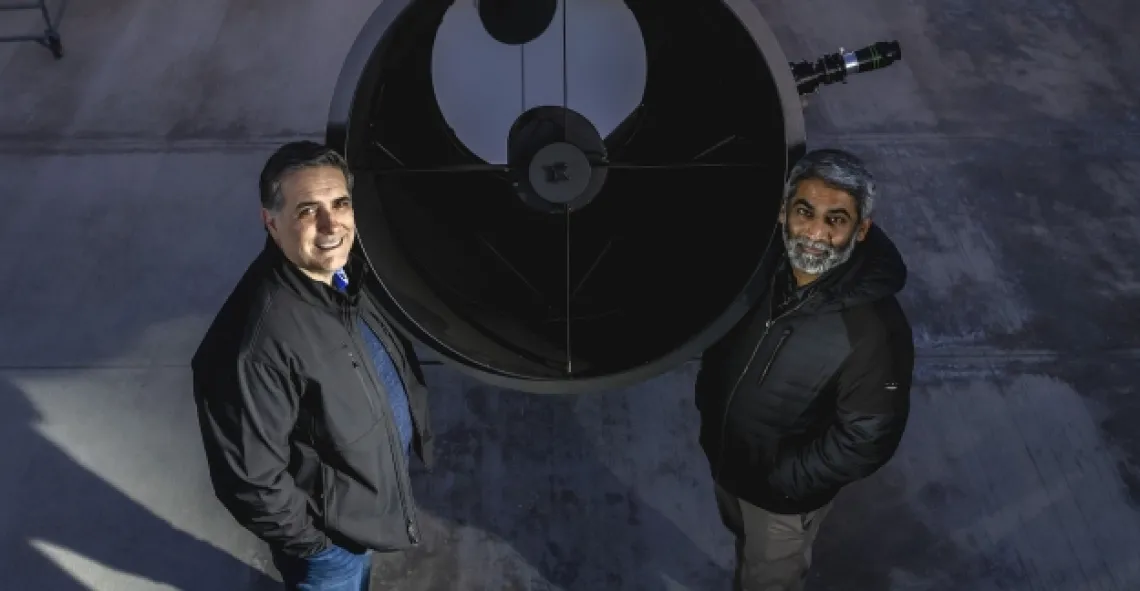New UArizona center focuses on safety, sustainability and security in space

Roberto Furfaro (left), professor of systems and industrial engineering, and Vishnu Reddy, professor of planetary sciences, at the Biosphere 2 Space Domain Awareness Observatory. Reddy and Furfaro are director and deputy director, respectively, of the new Space4 Center at the University of Arizona.
The Space4 Center is a partnership involving the College of Science, College of Engineering, BIO5 Institute and the Office of Research, Innovation & Impact.
Now more than ever, orbital space around Earth has become congested, contested and competitive. The University of Arizona's newly established Space4 Center is developing research and education solutions to ensure that use of orbital space remains safe, secure and sustainable for decades to come.
The "4" in the center’s name – which represents "space safety, security and sustainability" – also reflects the strategic areas of the four original university partners that came together to form the center: the College of Science, College of Engineering, BIO5 Institute and the Office of Research, Innovation & Impact.
"The University of Arizona has a moonshot culture; that is, we have permission to think big, take risks, and courageously address the world's most complex problems," said Elizabeth "Betsy" Cantwell, UArizona senior vice president for research and innovation. "Challenges related to national security and sustainability in space are certainly a moonshot, and they will not be solved by any single unit or college. Space4 is laying the groundwork to do ambitious, groundbreaking things in a rapidly changing field."
The center is led by director Vishnu Reddy; deputy director of engineering Roberto Furfaro; deputy director of data science Nirav Merchant, who also leads the university's Data Science Institute and the National Science Foundation-funded CyVerse platform; and deputy director of community engagement Walt Harris.
"The university has a strong legacy of detecting and tracking moving objects that goes back 50 years. Over the last five years, we have built a world-class academic space domain awareness program supporting the U.S. military," Reddy said. "The Space4 Center will build upon these to address grand challenges in space safety, security and sustainability."
Between 20,000 and 100,000 new satellites are forecast to be launched into space over the next decade, potentially creating a major traffic jam in space if not managed in a sustainable way, Reddy said.
Earlier this year, Reddy, a professor of planetary sciences, and Furfaro, a professor of systems and industrial engineering, received $7.5 million from the Air Force Research Lab to develop ways to detect, characterize and track objects in cislunar space, or the space between Earth and the moon. The university also operates a Space Domain Awareness Observatory complex, located near Biosphere 2. Reddy, Furfaro and Merchant are long-standing collaborators who, as part of a cooperative agreement with the U.S. Air Force, developed VerSSA, an extension of CyVerse's computational infrastructure focused on space domain awareness.
"The algorithms we develop using machine learning and artificial intelligence will be a game changer in tackling the space domain awareness problem. We have the perfect combination of hardware that is collecting exquisite data and cyberinfrastructure to harness the power of AI at the university," Furfaro said.
University of Arizona President Robert C. Robbins recently signed a memorandum of understanding with the University of Western Australia, creating a formal collaborative partnership between two universities with unparalleled expertise in orbital space.
"The University of Arizona has a long legacy of success in the space sciences, and I am excited to see how we will build upon those strengths with Space4 as we unite our experts across disciplines," Robbins said. "This new center will have a profound impact on an increasingly important strategic priority for our future. I am so glad to see the university leading research into orbital space security and sustainability, and I look forward to seeing what it will achieve."
Much of Space4's focus is on expanding upon the university's strengths by bringing additional interdisciplinary expertise and resources into the fold.
Creating a legal framework for operators in space, for example, is central to the future of space exploration. Space4 will collaborate with Andrew Keane Woods, professor of law, to develop a first-of-its-kind executive course in space law at UArizona. The course will be offered to UArizona students and industry leaders in collaboration with the university's D.C. Center for Outreach & Collaboration.
The center will also collaborate with the university's Institute for the Future of Data and Computing on workforce development and building expertise in data science specifically for classified environments.
While building upon university strengths, Space4 will give the university the opportunity to strategically align with federal research priorities during a once-in-a-generation moment in the nation's history.
The founding of the U.S. Space Force in 2019 came more than 70 years after the creation of the newest military branch – the U.S. Air Force – in 1947. Space Force is already funded at nearly the same level as NASA. President Joe Biden's fiscal year 2023 budget request for Space Force was $24.5 billion, compared to NASA's $26 billion, and 65% of those funds will be dedicated to research development.
UArizona research is already heavily funded by NASA, with the university ranking fifth in the nation among public universities for NASA-funded research activity. UArizona is leading OSIRIS-REx, NASA's first mission to collect and return to Earth a sample from the surface of an asteroid. The mission was recently extended to study the near-Earth asteroid Apophis for 18 months. UArizona also leads both the Catalina Sky Survey and Spacewatch programs, which have discovered more than half of all known near-Earth asteroids.
"We already have a lot of credibility with NASA, doing not just basic science, but operational, applied research," Reddy said. "By creating the Space4 Center and getting more tuned towards addressing the needs of Space Force, in addition to the needs of NASA, we have the chance to get in on the ground floor and help Space Force as they tackle national security challenges in space."

